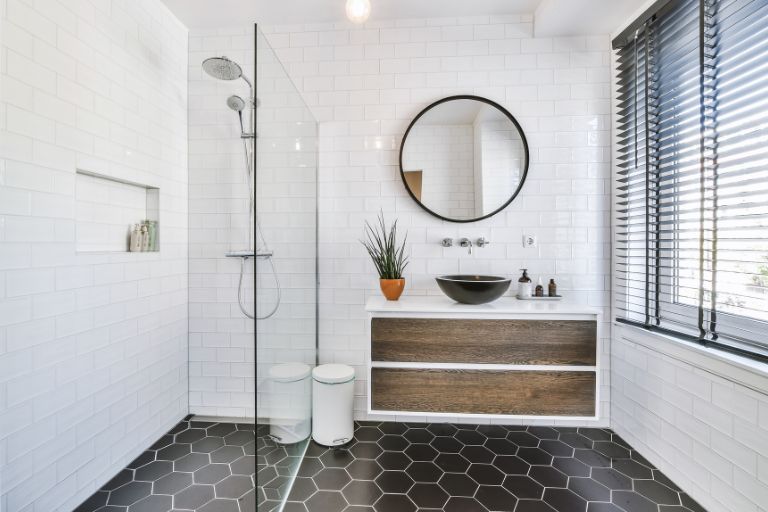Drain flies, also known as moth flies, sewer gnats, or sink flies, can be a persistent nuisance in your bathroom. These small, fuzzy pests thrive in damp environments, especially in areas with stagnant water and organic matter. Here’s a comprehensive guide to understanding, identifying, and effectively eliminating drain flies from your bathroom.
How to Identify Drain Flies?
Drain flies are often mistaken for fruit flies due to their small size and tendency to hover around sinks and drains. These pests measure approximately 1/16 to 1/5 inch long and have light gray or tan bodies covered with hair, giving them a fuzzy appearance. They are typically found near sinks, bathtubs, showers, and other areas with standing water.
What Do Drain Fly Eggs Look Like?
Drain fly eggs are small, brown or cream-colored, and are usually found in clusters. Female drain flies lay their eggs in wet, organic matter such as the slime layer inside drain traps or garbage disposals. These eggs hatch within 32 to 48 hours, and the larvae feed on the organic material in the drains, maturing into adults within 7 to 28 days.
How to Check for Drain Flies in Your Bathroom
To confirm a drain fly infestation, try these methods:
Use Duct Tape
- Tape Method: Place a piece of duct tape over the drain opening overnight, sticky side down. If you find flies stuck to the tape in the morning, you likely have an infestation in that drain.
Check the Drain Cover
- Inspect for Larvae: Remove the drain cover and use a flashlight to check for thin, tube-like larvae within the slimy buildup. If you find larvae, it confirms that the flies are breeding in your drain.
How to Get Rid of Drain Flies
Clean the Drains
Thoroughly cleaning the drains is crucial to eliminating drain flies, as it removes their breeding grounds.
Mechanical Cleaning
- Remove Debris: Use a drain brush or pipe cleaner to scrub the inside of the drain, removing any buildup of organic matter.
- Plunger: Use a plunger to help dislodge any blockages and flush out organic material.
Chemical Cleaning
- Drain Cleaner: Use a commercial drain cleaner or a homemade solution to clean the pipes thoroughly. Avoid using harsh chemicals that can damage your plumbing.
- Baking Soda and Vinegar: Pour a mixture of 1/2 cup baking soda, 1/2 cup salt, and 1 cup vinegar down the drain. Let it sit overnight, then flush with boiling water in the morning.
Use Natural Remedies
Natural remedies can be effective in reducing the drain fly population.
Boiling Water
- Boil Water: Pour boiling water down the drain once or twice daily for about a week to kill larvae and flush out organic material.
Apple Cider Vinegar Trap
- Vinegar Trap: Fill a bowl with apple cider vinegar and cover it with plastic wrap, poking small holes in the wrap. Place it near the drain. The flies will be attracted to the vinegar, enter the trap, and be unable to escape.
Soap and Water Trap
- Soap Solution: Fill a bowl with water, add a few drops of dish soap, and place it near the infested area. The soap breaks the surface tension, causing the flies to sink and drown.
Preventing Drain Fly Infestations
Regular Drain Maintenance
- Clean Regularly: Clean your drains regularly using a drain brush and enzyme-based cleaners to prevent the buildup of organic matter.
- Drain Covers: Use drain covers or screens to prevent debris from entering the drains and creating breeding grounds.
Fix Leaks and Reduce Moisture
- Repair Leaks: Fix any leaks in your plumbing to reduce moisture, which attracts drain flies.
- Use a Dehumidifier: In humid environments, use a dehumidifier to reduce moisture levels in the bathroom.
Proper Ventilation
- Ventilate the Bathroom: Ensure your bathroom is well-ventilated to reduce moisture. Use an exhaust fan or open windows after showers and baths to allow humidity to escape.
Drain Fly Facts, Habits, and Threats
Habits
- Weak Fliers: Drain flies are weak fliers and prefer to stay near their breeding sites. They are often found resting on walls near drains and are most active during the evening hours.
- Breeding Sites: They breed in damp, organic material, typically found in drains, sewers, and septic tanks.
Environment
- Damp Areas: Drain flies thrive in wet or moist areas with organic material, such as storm drains, compost piles, or decaying leaves and logs.
- Nourishment: They feed on flower nectar, sewage, and polluted water.
Threats
- Health Concerns: While drain flies don’t bite or sting, they can carry bacteria from contaminated areas. Their decaying bodies can also cause allergic reactions in some individuals.
- Plumbing Issues: They can clog pipes and spread bacteria, leading to potential plumbing issues and health concerns.
FAQs About Getting Rid of Drain Flies
What causes drain flies?
Drain flies are attracted to stagnant water and organic matter in drains, sewers, compost piles, and other damp areas. Poor sewage drainage or overflows can create ideal breeding grounds for these pests.
Will drain flies eventually go away?
Killing adult drain flies is a temporary solution. To eliminate them for good, you need to address the source of the infestation by cleaning and maintaining your drains.
Where do drain flies lay eggs?
Drain flies lay eggs in wet organic matter, such as the buildup in clogged drains, sewage, compost piles, storm drains, and septic tanks.
What do drain flies feed on?
Drain flies feed on flower nectar, sewage, and polluted water. They can spread bacteria from garbage and rotting organic materials.
Will bleach kill drain flies?
While bleach can kill some drain flies, it is not effective against their eggs, which have a protective coating. A thorough cleaning with enzyme-based or natural solutions is more effective.
How long do drain flies live?
Drain flies have a short lifespan, typically living between 8 to 24 days. However, they reproduce quickly, which can lead to a continuous infestation if not addressed promptly.
Are drain flies harmful to humans?
Drain flies are not harmful to humans in terms of bites or stings, but they can carry bacteria from sewage and other contaminated areas. Their presence can lead to allergic reactions in sensitive individuals and contribute to unsanitary conditions.
How can I prevent drain flies from coming back after treatment?
To prevent drain flies from returning, maintain clean and dry drains, fix any leaks promptly, use drain covers, and ensure proper ventilation in your bathroom. Regularly cleaning your drains with natural or enzyme-based cleaners can also help prevent reinfestation.
Can drain flies infest other parts of the house?
While drain flies are commonly found in bathrooms, they can infest any area of the house with suitable breeding conditions, such as kitchens, basements, and areas with standing water or dampness.
How can I distinguish drain flies from other small flies?
Drain flies have distinctive hairy bodies and wings, giving them a moth-like appearance. They are generally darker and fuzzier than fruit flies and have a unique wing vein pattern that sets them apart from other small flies.
Do drain flies carry diseases?
Drain flies themselves do not carry diseases, but they can transfer bacteria and pathogens from sewage and other contaminated areas to surfaces in your home, potentially leading to health issues.
Can I use professional pest control services for drain flies?
If home remedies and regular cleaning do not eliminate the infestation, professional pest control services can provide more thorough and effective treatments to eradicate drain flies and prevent future infestations.






